Crane (machine)
![]()
The title of this article is ambiguous. For other meanings, see Crane (disambiguation).
A crane (plural: cranes or cranes - cranes is usually considered colloquial, cranes technical; etymologically related to ancient Greek γέρανος géranos, German 'Kranich') is a device operated manually or by motors for the vertical and horizontal loading or movement of loads. It is usually used for loading and unloading ships (general cargo and containers), railways and trucks, as well as in assembly, manufacturing and storage halls and in building construction.
In the version for handling bulk materials, it is usually referred to as an excavator.
The difference to a simple hoist, which can be part of the crane, is that the crane works without flight and can perform more than two directions of movement (up/down - left/right corresponds to two coordinate directions) (three-dimensional working range)- i.e. to set down the load at a different point than it picked it up.
The main application is loading and unloading, also called cargo handling, as well as loading goods to a specific point (short distances). The latter application is very important, especially on construction sites.
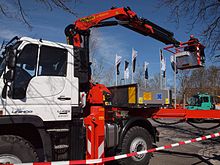
Loading crane on a Unimog U423 (2014)

Pressurized water slewing crane in Bremerhaven (1899)
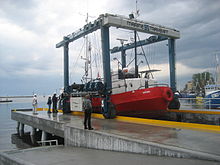
Travellift
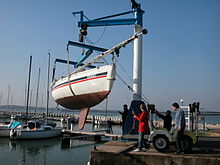
Pillar-mounted slewing crane
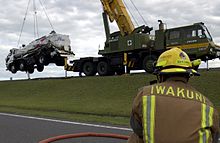
Vehicle crane
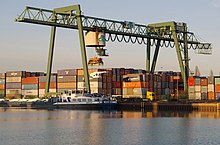
Loading bridge
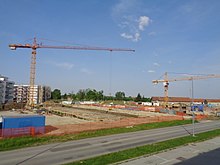
Lattice boom cranes
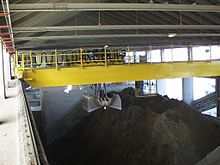
Bridge Crane
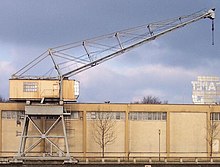
Portal slewing crane with fixed jib
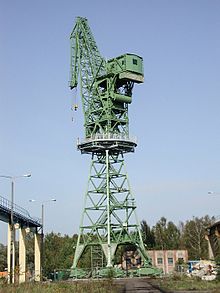
A portal luffing jib crane - the Montageeber in Eberswalde
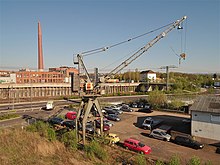
Small gantry crane on rails
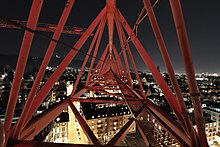
jib crane
Crane types
There are different types and designs depending on the application.
- Overhead crane, mistakenly called indoor crane, overhead crane or suspension crane runway.
- Gantry crane built like a gate, rail runway / track runway built on the ground (corridor) or trackless gantry crane on wheels/crawler.
- Jib Crane
- Semi-gantry crane
- Loading bridge, crane bridge e.g. at the port
- Portal luffing jib crane
- Full gantry luffing slewing crane
- Derrick Crane
- Cable crane, cableway crane, slipway crane (shipyard, logging crane)
- Bracket crane
- Pillar-mounted slewing crane
- Jib crane
- Floating crane
- Aircraft hoist crane
- Stacking crane
- Tower crane also called tower crane, construction crane, top and bottom slewing crane
- rail-mounted mobile cranes
- Rail crane, slewing rail crane, overhead rail crane.
- Overhead Crane
- non-rail mobile cranes
- Truck crane, mobile crane
- all-terrain low-speed cranes (rough terrain cranes)
- All-Terrain Cranes
- Crawler crane
- Travellift (to lift ships out of the water and transport them to the shipyard)
- Ring crane (1 or 2 rail rings, each for 4 multi-wheeled trolleys, to transfer the load over a large area into the ground)
- Loading crane (for loading and unloading trucks and ships)
- Ship crane, shipboard crane
- stationary container crane as loading or unloading bridge for container ships
- Special cranes (loading bridges) for special cargoes such as grain and tropical fruit (bananas)
- Stationary, permanently installed cranes and lifts in multi-storey warehouses and construction sites. Electric drive, formerly drive via treadmill, göpel or similar.
- Large crane
Differentiation according to mast construction
- Telescopic crane
- Lattice boom crane
Mobile jib cranes are called mobile cranes.
Hans Liebherr designed the world's first mobile tower crane, the TK 8, in 1949, with initially moderate success.
Miscellaneous
Helicopters, cable cars, balloons and kites (ferries) can take over the function of a crane if necessary. However, their use is usually limited to impassable areas or for work on very high structures because of the high operating costs. Helicopter types specially designed for crane use are: K-Max, Sikorsky S-64 Skycrane, Mil Mi-10, and a trial balloon was CargoLifter CL75 AirCrane with 75 t payload in 2001/2001.
Functionally similar to the following tools: fishing rod, ship's hook, grappling aid, fire hook, hook bar to manipulate clothes on hangers on high bars or to tip small boxes down from high shelves.
30 cranes on 21 hectares moved in the dusk of 15 February 2014 as a ballet choreographed with light effects to the 15-minute symphony Kranensee, composed by Florian Reithner, on the large construction site of the Urban Lakeside Aspern being built in the northeast of Vienna. With this, the construction companies celebrated the first roof levels and 14,000 came to watch. Crane ballets were already performed in 1996 during the redesign of Potsdamer Platz Berlin and in 2010 as Requiem of the Cranes in HafenCity Hamburg.
The term crane ballet has been used in recent years as an embellishing description for the mere accumulation of cranes, for example on large construction sites.
Search within the encyclopedia